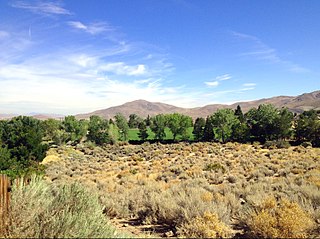
The Truckee Meadows is a valley in Northern Nevada, named for the Truckee River, which collects and drains all water in the valley. Truckee Meadows is also colloquially used as a name for the Reno–Sparks metropolitan area, even though the metro area includes areas outside this valley. The name for the valley in the Washo language is Welganuk.

Tetradymia axillaris is a flowering plant in the daisy family known by the common names longspine horsebrush and cottonthorn. This is a plant of the sagebrush and desert plant communities of the southwestern United States.
Hulsea californica is a rare species of flowering plant in the family Asteraceae known by the common names San Diego alpinegold and San Diego sunflower. It is endemic to southern California, where it grows only in the Peninsular Ranges.
Lessingia micradenia is a rare species of flowering plant in the family Asteraceae known by the common name Mt. Tamalpais lessingia. It is endemic to the San Francisco Bay Area of California, where it occurs in areas with serpentine soils. The species is divided into two rare varieties, each with a limited occurrence on opposite sides of the Bay Area. Lessingia micradenia var. glabrata is found in several locations across Santa Clara County south of San Jose, while var. micradenia is known only from a few spots around Mount Tamalpais in Marin County.
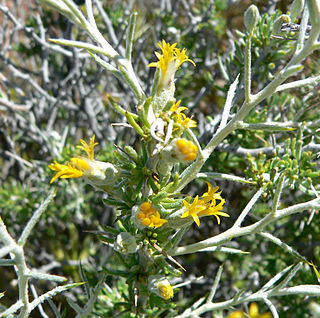
Tetradymia is a genus of North American shrubs in the groundsel tribe within the sunflower family. Horsebrush is a common name for plants in this genus.

Stenotus lanuginosus is a species of flowering plant in the family Asteraceae known by the common names woolly mock goldenweed and woolly stenotus.
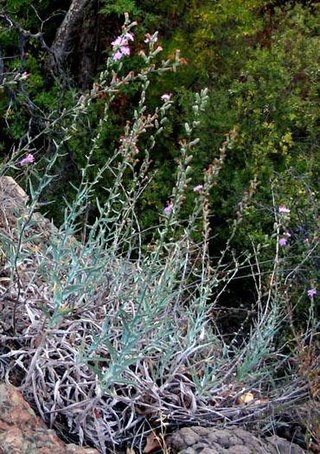
Stephanomeria cichoriacea is a species of flowering plant in the family Asteraceae; it is known by the common names chicoryleaf wirelettuce and silver rock-lettuce. It is endemic to California, where it grows in the coastal mountain ranges as far north as Monterey County, but especially in southern California mountains such as the Transverse Ranges. Its habitat includes chaparral. It is a perennial herb producing slender erect stems reaching maximum heights exceeding one meter. The stem is woolly with hairs, especially on new growth. The leaves are mostly located in a basal rosette, the largest reaching 18 to 20 centimeters long. They are lance-shaped and often toothed along the edges, and the newer ones are woolly. Smaller leaves occur farther up the stem. The inflorescence is a long array of several flower heads, with some occurring in the upper leaf axils as well. Each head has a cylindrical base 1 to 2 centimeters long which is lined with layers of glandular phyllaries. The head contains 10 to 15 ray florets, each with an elongated tube and a pink ligule which may be up to 2 centimeters long. The fruit is an achene tipped with a spreading cluster of long, plumelike pappus bristles.
Tetradymia argyraea is a species of flowering plant in the aster family known by the common names striped cottonthorn and striped horsebrush. It is native to the desert mountains of the southwestern United States, particularly of California, Nevada, and Arizona, where it grows in desert woodland habitat. It is a woolly, spiny shrub growing one half to nearly two meters in maximum height. The erect stems are white-woolly except for bare stripes at intervals. The leaves are linear in shape and harden as they age, becoming spiny. The larger leaves are woolly and there are clusters of smaller, threadlike leaves which may be hairless. The inflorescence bears two to five flower heads which are each enveloped in five thick phyllaries coated in white woolly hairs. Each head contains five pale yellow flowers each around a centimeter long. Flowers are produced in summer, as late as September. The fruit is an achene a few millimeters long tipped with a pappus of bristles.
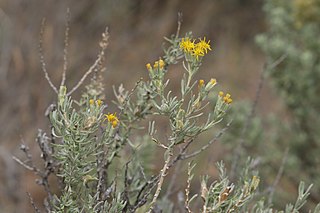
Tetradymia argyraea is a species of flowering plant in the aster family known by the common names spineless horsebrush and gray horsebrush. It is native to western North America.
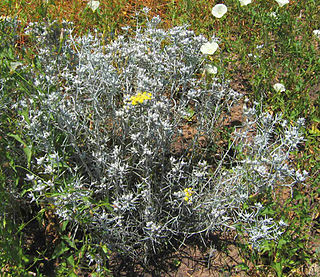
Tetradymia comosa is a species of flowering plant in the aster family, known by the common name hairy horsebrush.

Tetradymia spinosa is a species of flowering plant in the aster family known by the common name shortspine horsebrush. It is native to the western United States, especially the basins and plateaus west of the Rocky Mountains. It grows in sagebrush, woodlands, and scrub habitat, often among shadscale in alkaline areas such as playas. It is a bushy shrub with many branches coated in woolly white fibers and growing to a maximum height around a meter. The leaves are narrow, curving, and hooklike, hardening into sharp spines up to 2.5 centimeters long. The inflorescence bears one or two flower heads which are each enveloped in four to six woolly phyllaries. Each head contains up to 8 tubular yellow disc flowers up to 1 cm long. The fruit is a densely hairy achene which may be nearly 2 cm long, including its pappus of long bristles.

Tetradymia stenolepis is a species of flowering plant in the aster family known by the common name Mojave cottonthorn. It is native to the deserts around the intersection of Arizona, Nevada, and eastern California, where it grows in woodland and scrub habitat on sandy and gravelly substrates. It is a bushy shrub with many branches coated in woolly white fibers and growing to a maximum height just over a meter. The narrow leaves are 2 or 3 centimeters long and harden into straight, sharp spines. Clusters of woolly leaves grow near the spines. The inflorescence bears up to 7 flower heads which are each enveloped in four or five woolly phyllaries. Each head contains up to four or five tubular yellow flowers each around a centimeter long. The fruit is a hairy achene which may be nearly 2 centimeters long, including its pappus of long bristles.
Tetradymia tetrameres is a species of flowering plant in the aster family known by the common name fourpart horsebrush and dune horsebrush. It is native to the Great Basin, where it occurs in western Nevada and just over the border in Mono County, California. It is a plant of dry scrub and sand dunes. It is a bushy, woolly shrub with many erect, spineless branches. It is the largest of the horsebrushes, growing up to two meters in height. The soft, woolly leaves are narrow and threadlike, growing up to 4 centimeters long. Shorter leaves occur in clusters around the primary leaves. The inflorescence bears 4 to 6 flower heads which are each enveloped in four or five woolly phyllaries. Each head contains up to four or five light yellow flowers each around a centimeter long. The fruit is a hairy achene which may be up to a centimeter long, including its pappus of long bristles.

Trifolium macrocephalum is a species of clover known by the common name largehead clover or bighead clover native to the Great Basin region of the western United States.
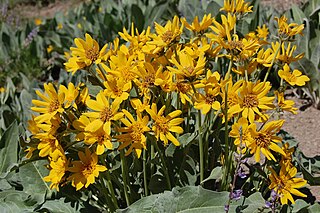
Wyethia mollis is a species of flowering plant in the family Asteraceae known by the common name woolly mule's ears. The plant is hairy to woolly in texture, sometimes losing its hairs with age.

Schoenocrambe argillacea is a rare species of flowering plant in the mustard family known by the common names clay reed-mustard, Uinta Basin plainsmustard, and clay thelypody.

Artemisia rigida is a species of flowering plant in the aster family known by the common names scabland sagebrush and stiff sagebrush. It is native to the northwestern United States, in Washington, Idaho, and Oregon. It has been recorded in western Montana but these sightings may have been misidentifications.
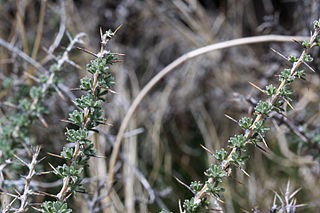
Tetradymia nuttallii is a species of flowering plant in the aster family known by the common name Nuttall's horsebrush. It is native to the western United States, where it occurs in Nevada, Utah, Wyoming, and Colorado.
Eriogonum crosbyae is a species of wild buckwheat known by the common name Crosby's buckwheat. It is native to southcentral Oregon and northwestern Nevada in the United States. Some treatments include plants in Montana and Idaho as members of this species. This plant was first discovered in the Guano Valley in Lake County, Oregon, in 1978 by Bureau of Land Management botanist Virginia Crosby, and it was named for her in 1981.
Eriogonum diatomaceum is a species of wild buckwheat known by the common name Churchill Narrows buckwheat. It is endemic to Nevada in the United States, where it is known only from the Pine Nut Mountains in Lyon County. It is limited to the Churchill Narrows near Fort Churchill State Historic Park. This plant was discovered in 1997 and described to science in 2002.















